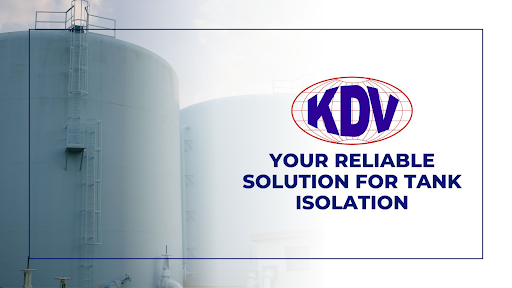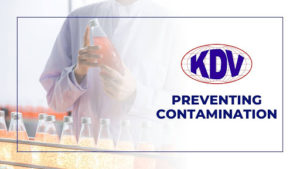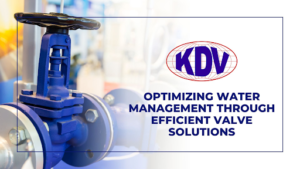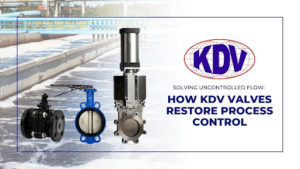Your Reliable Solution for Tank Isolation
In industries handling liquids, isolating storage tanks is crucial for filling, emptying, maintenance, and safety procedures. Traditional tank isolation methods can be unreliable, risking leaks or incomplete isolation. KDV Valves provide superior solutions through advanced sealing technology, automation options, and rugged construction – ensuring safety and efficiency throughout your operations.

The Problem: Ineffective Tank Isolation
The consequences of improper tank isolation can be severe:
- Leaks and Spills: Faulty seals or incorrectly opened valves can lead to harmful spills, compromising worker safety and posing significant environmental hazards. In industries dealing with hazardous chemicals or food production, even minor leaks can result in regulatory fines and health risks.
- Product Contamination: Even small leaks can contaminate the contents of the tank, potentially ruining valuable products and causing costly delays. In pharmaceutical and beverage industries, cross-contamination can lead to non-compliance with strict safety standards.
- Production Downtime: Troubleshooting and cleaning up leaks due to inadequate isolation wastes valuable production time and resources. This not only affects operational efficiency but can also lead to missed production targets and supply chain disruptions.
Limitations of Traditional Methods
- Manual Valves: Traditional valves solely operated by hand are susceptible to human error. Incorrectly closed valves or incomplete isolation compromise safety and efficiency. This is especially problematic in high-risk environments where strict safety procedures must be followed.
- Unreliable Seals: Seals deteriorate over time, especially with exposure to harsh chemicals or extreme temperatures, eventually leading to leaks. Regular maintenance is required, but without proper monitoring, undetected seal failures can lead to unexpected shutdowns.
How KDV Valves Solve the Problem
KDV Valves are engineered to overcome these challenges:
- High-Performance Sealing Technology: KDV’s seals are designed for maximum effectiveness, offering leak-proof tank isolation. This safeguards the environment, prevents contamination, and gives you peace of mind. Our advanced sealing systems are rigorously tested to comply with industry standards, ensuring long-term performance.
- Automated Operation: Automation features minimize the potential for human error and speed up processes. Isolation valves can be linked to control systems, streamlining procedures and ensuring correct execution. For industries requiring precise tank level control, automated valves can be integrated with sensors and remote monitoring systems for real-time adjustments.
- Durable Construction: KDV Valves are built with robust materials to withstand demanding environments and the rigors of frequent use. From stainless steel to corrosion-resistant coatings, KDV ensures longevity even in highly abrasive or acidic conditions.
Specific Valve Options: KDV offers various valve types ideal for tank isolation, including butterfly valves, ball valves, and more. Their specialists can help you choose the perfect solution based on your specific needs for applications such as chiller isolation, selecting the right valve type is essential to maintaining system efficiency and preventing unnecessary energy losses.
Important Considerations for Tank Isolation Valves
- Sealing Effectiveness: The primary function of an isolation valve is to provide a secure seal. KDV uses the latest materials and designs for exceptional leak prevention. This is particularly important in industries where strict isolation is necessary to maintain process integrity.
- Material Compatibility: Choose valves constructed with materials compatible with the chemicals or liquids stored in your tanks to ensure long service life and prevent contamination. For example, PTFE-lined valves are preferred for handling highly aggressive chemicals, while stainless steel is widely used in food and beverage applications.
- Flow Control: Fine-tuned flow control is often essential for tank filling, emptying, and maintenance tasks. KDV Valves give you precise adjustment capabilities. This allows for smoother operation, reducing pressure fluctuations that can impact system stability.
- Safety Features: KDV Valves may include pressure relief mechanisms or other features designed to further enhance operational safety. In addition, lockable handles or fail-safe actuators can be integrated to prevent accidental valve operation in hazardous areas.
Using KDV Valves for tank isolation delivers tangible benefits:
- Enhanced Safety and Environmental Protection
- Improved Efficiency and Productivity
- Reduced Maintenance Costs
FAQs on Reliable Solutions for Tank Isolation Valves
What factors should be considered when selecting an isolation valve for a corrosive or high-temperature tank application?
When choosing an isolation valve for extreme conditions, factors such as material compatibility, temperature and pressure ratings, and sealing integrity are critical. PTFE-lined, stainless steel, or Hastelloy valves are commonly used for corrosive media, while high-temperature alloys and fire-safe designs are preferred for heat-intensive environments.How can automated isolation valves improve operational efficiency in tank level control systems?
Automated isolation valves can be integrated with SCADA, PLC, or DCS control systems to provide precise remote operation, real-time monitoring, and automatic shut-off in case of system anomalies. This reduces human error, enhances safety, and allows for predictive maintenance, minimizing downtime.What are the key differences between ball valves, butterfly valves, and diaphragm valves for tank isolation applications?
Ball valves offer tight shut-off and are ideal for high-pressure applications, but they require more space and may not be ideal for throttling.
Butterfly valves provide cost-effective isolation with a compact design but may have limitations in sealing performance for critical applications.
Diaphragm valves are excellent for hygienic and corrosive applications as they eliminate contact between the media and moving parts, making them a top choice for industries such as pharmaceuticals and food processing.
What maintenance strategies help ensure long-term reliability of tank isolation valves?
Regular inspection, seal replacement, and actuator testing are crucial for ensuring valve longevity. Using condition monitoring sensors to detect early signs of wear, leaks, or pressure drops can prevent unplanned failures. Additionally, selecting the correct valve material for the specific application helps reduce corrosion and mechanical wear over time.How do double block and bleed (DBB) valves enhance safety and reliability in tank isolation?
DBB valves provide an additional layer of isolation by using two sealing mechanisms with a bleed function, ensuring no trapped fluid remains between isolation points. This setup is particularly beneficial for hazardous chemical storage, refineries, and high-pressure applications, where complete isolation is critical to prevent accidental leaks and ensure safe maintenance procedures.
If you are looking for a reliable, efficient, and safe solution for tank isolation, contact the experts at KDV Valves. They’ll help guide you to the perfect valves for your system and operational requirements. With extensive experience across various industries, KDV’s team can assist in selecting the most suitable isolation valves for applications including water treatment, chemical processing, and energy systems.


